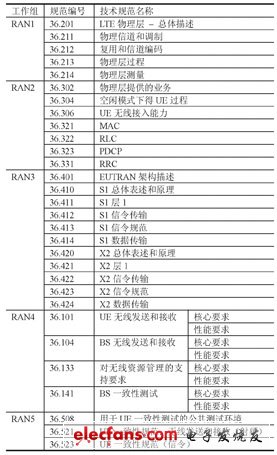3GPP TSG RAN is responsible for the standardization of LTE radio access networks and is divided into five working groups (RAN1 / 2/3/4/5).
In the TD-LTE specification architecture, the physical layer specification is 36.2xx, the protocol layer specification is 36.3xx, and the structure and interface specification is 36.4xx. It belongs to the functional specification and describes the behavior of the network and the terminal. The radio frequency specification 36.1xx belongs to the performance specification. The network and terminal coexistence, interference and performance indicators are included; and the terminal conformance test specification 36.5xx is an implementation specification, which mainly involves three parts of radio frequency conformance, RRM conformance, and protocol conformance testing (see Table 1). Currently FDD It is the same test standard as the TDD terminal conformance test standard.
Table 1 LTE wireless access network technical specifications list

(1) RF conformance test
The LTE terminal radio frequency conformance test standard is 3GPP 36.521-1, and its technical requirement standard is 3GPP 36.101. Unlike 3G, for FDD and TDD terminals, the LTE terminal RF test standard is the same test standard, and most test indicators are common to FDD and TDD. The overall requirements of the LTE terminal radio frequency indicators are: for the transmitter, on the one hand, it is required to be able to accurately generate LTE useful signals that meet the requirements of the standard, on the other hand, it is required to control the level of unwanted emissions and interference to a certain level; for the receiver, it is required to Under certain environmental conditions, it can receive and demodulate useful signals reliably and accurately, and can resist certain interference signals.
TD-LTE terminal RF test items are divided into four major parts: transmitter indicators, receiver indicators, performance requirements, and channel status information reporting. Although the LTE signal structure is different from UMTS, the LTE terminal RF test requirements basically come from the UMTS defined RF requirements, and only a small number of new test items are added. In the receiver and performance statistics, the UMTS system measures the receiving performance through BER and BLER, while the LTE system measures it through the throughput. In the performance test part, the channel demodulation performance index for LTE channel structure is also increased.
(2) Radio resource management (RRM) conformance test
Wireless resource management is the planning and scheduling of the air interface resources of the mobile communication system to achieve optimal resource use efficiency, thereby meeting the wireless resource-related requirements defined by the system. The LTE terminal radio resource management conformance test standard is 3GPP 36.521-3, and its technical requirement standard is 3GPP 36.133. For FDD and TDD terminals, the LTE terminal RRM test standard is the same test standard, but since the resources such as FDD and TDD channels are different, the test examples are described separately and cannot be used universally.
The TD-LTE radio resource management conformance test project is divided into six parts: Idle state mobility management, connection state mobility management, RRC connection control, transmission time characteristics, test process and measurement performance. Compared with the UMTS RRM test, it mainly increases the interoperability between different access technologies, that is, FDD / TDD modes such as GSM, UTRAN, CDMA HRPD, cdma2000 1x, and E-UTRA, such as reselection and handover. , Channel measurement, etc.
(3) Protocol conformance test
The TD-LTE protocol conformance test is to test the consistency of the air interface protocol signaling interaction. The protocol consistency use case is layered according to the protocol and includes the following parts: idle mode operation, MAC, RLC, PDCP, RRC, EPS mobile Process, session management, radio bearer test, combined process and general test, etc. The LTE protocol conformance test standard specification is the TS36.523 series, TS36.523-1 is the protocol conformance test method, TS36.523-2 is the test conditions and terminal PIX capability description ImplementaTIon Conformance Statement (ICS), TS36.523-3 It is the TTCN code part.
Bluetooth Speaker Portable Bluetooth 4.0 Stereo Speaker
The Bluetooth Speaker with Superior Sound Clarity and Playtime.
Superior Sound Clarity and Loudness, music with unmatched sound clarity and just the right amount of bass. Boasting less than 1% total harmonic distortion, SoundCore outputs more music and less noise and sounds better and even more powerful ones.
Incredible Battery Life
Playing for up to 24 hours
Uncompromised Portability
Sounding great, we've designed it using a unique design. The result is a clean bass sound you can easily pick up and put in your bag.
Bluetooth 4.0 Connectivity
Latest Bluetooth technology to ensure lossless CD-quality audio streaming.

Bluetooth Speaker
Bluetooth Speaker,Portable Bluetooth Speakers,Wireless Bluetooth Speakers,Mini Bluetooth Speaker
Shenzhen Greater Industry Co., Ltd. , https://www.szgreater.net
